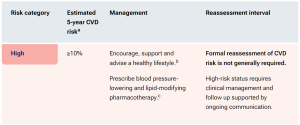2.17 Treatment Targets
John Smithson
Be able to:
- Use the AusCVD risk assessment tool risk calculation to determine appropriate treatment and cholesterol reduction targets for a patient with CVD risk or pre-existing CVD disease.
Treatment targets for cholesterol are aligned to the patient’s AuSCVD risk level
Targeting CVD risk assessment to recommended age groups enables people at high risk of CVD to be identified early before they develop overt disease. This approach helps direct pharmacological strategies for intensive CVD risk factor management to people at high risk and diverts unnecessary interventions away from people at lower risk. Cardiovascular disease (CVD) risk assessment and management in people without known CVD involves:
- identifying the appropriate people to be assessed;
- using the Australian cardiovascular disease risk calculator (Aus CVD Risk Calculator) to estimate their risk;
- identifying their risk category (see below);
- communicating their risk to them; and managing their risk.
Irrespective of management approach, for example non-pharmacological (drug) (SNAP and weight management) approach, or drug + non-drug approach, we need a target in mind to aim for. The information below provides targets for cholesterol levels based upon level of risk.
Now, understanding this, let’s reconsider Alf. You will remember Alf’s CVD risk over the next 5 years was 10% (we elevated the category due to his Indigeneity).

If we consult the AusCVD risk guideline and look at the Overview of CVD risk management according to risk category, we would find the following information:

According to the treatment strategy, we would:
- Commence lifestyle changes PLUS
- Commence lipid lowering drug therapy.
We would target Alf’s cholesterol level to which of the following? If we consider the information on target cholesterol levels, we would be aiming for the following cholesterol levels:
- LDL-C target: At least 50% reduction in LDL-C from baseline and less than 1.8 mmol/L, whichever is lowest
- non–HDL-C target: less than 2.6 mmol/L
- triglycerides target: less than 1.7 mmol/L
… remember, the relationship between cholesterol levels and CVD risk is continuous, that is the lower the cholesterol level, the lower the risk… so we try to get it to target level, but any progress towards that level is better than no progress at all.
COMMONWEALTH OF AUSTRALIA Copyright Regulations 1969 WARNING
This material has been reproduced and communicated to you by or on behalf of James Cook University in accordance with section 113P of the Copyright Act 1969 (Act).
The material in this communication may be subject to copyright under the Act. Any further reproduction or communication of this material by you may be the subject of copyright protection under the Act. Do not remove this notice.
